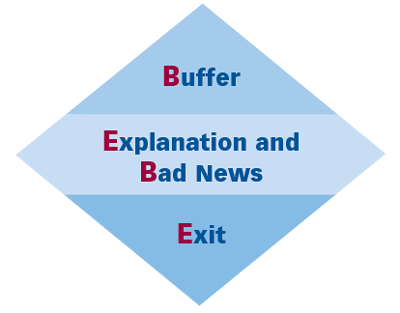
No one likes to be the bearer of bad news, but it’s a role you’ll likely have to take on at some point in your career.
Delivering bad news in writing presents an especially thorny communication situation. On the one hand, you must express the news accurately, leaving your reader with a clear understanding of the issue, problem, action, or outcome. On the other hand, you must express the news tactfully if you are to maintain (or gently end) the relationship.
This eTip will help you achieve both of these objectives.
When you break bad news, don’t start with the bad news. Instead, begin with a buffer that connects you to your reader. Then provide an explanation leading up to the bad news. Finally, exit by focusing on the future.
Use the BEBE strategy: Buffer + Explanation + Bad news + Exit.

Note: If the bad news you are sharing is minor, or if your reader expects it, you may choose a more direct approach by stating the news right away.
Use your buffer statement to cushion the blow of bad news and establish a voice of reason and respect. Try one or more of these strategies:
Thank you for your bid to design and develop Everson's new eight-acre city park.
Thanks for suggesting that Rankin create remote work possibilities for all staff. I've been intrigued with this work concept for some time.
We have finished investigating your concerns about the ATV16 drives that you installed for American Linc Company. We do understand that the drive and serial-link failures have inconvenienced both you and American Linc.
Your bid was competitive for several of the criteria outlined in our original RFP.
Strive for a neutral tone of voice, even if you harbor negative feelings about the subject or situation. Strong negative emotion never comes across well in writing. Make sure your emotions are in check when you write your message.
Be honest, but not blunt. Make sure you explain why a certain action or decision is necessary. Use pronouns such as we and our to connect with the reader. Avoid you and your in negative contexts because they can create an accusatory tone.
Notice how the you and your in this example pits the writer against the reader.
Youngstown Microchip used to know how to pack an order, but now you can’t get a single shipment out on time with the right stuff in it. You should fire your warehouse supervisor, Nick Luther, before Rankin Technologies fires you.
Rankin Technologies has always valued our partnership with Youngstown Microchip. Within the last six months, however, late shipments and incorrectly filled out orders have impacted our working relationship. We need to solve these problems, or we’ll need to find another vendor.
The following bad-news message is abrupt and disrespectful. Rewrite the message using some (or all) of the strategies from above. Scroll down to see one possible revision.
There is no way we can allot you an additional $7,000 for prototype materials. Do you honestly think we can afford something like that at a time like this? No way.
Put on your problem-solving pants and figure out another way to get the thing built within budget. The clock is ticking. You need to build an adequate prototype for the May 16 partner meeting. Stop focusing on fantasies about budget and spend more time on building.
Check out the Write for Business Guide and past eTips for more resources for difficult writing situations.
Thanks for reaching out about your prototype proposal. We appreciate the thinking you are putting into the project and understand your concern about the current budget. Under normal financial circumstances, we could likely fulfill your request for an additional $7,000 for materials. However, in these uncertain times, we cannot commit the extra money.
We understand that this means the prototype might not be fully functional for the May 16 meeting with potential partners. We have accepted this reality and will not hold it against you. That said, let’s work together to brainstorm some creative (and less expensive) workarounds that would allow us to display an impressive prototype, even if it’s only partially functional.
Here’s one idea: Could we use 3-D printing for the ancillary pieces and allocate the full budget to materials for the base product?
Take some time to think through the situation, and let’s reconnect at the end of the week.
Zero spam. Unsubscribe at any time.